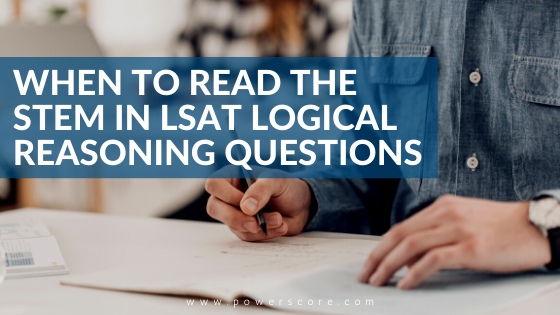Among LSAT experts, few issues are more hotly debated than this one: should you read the question stem before or after reading the stimulus in LSAT Logical Reasoning questions? PowerScore’s position on this issue has always been clear: read the stem after reading the stimulus. On this issue, we are, shall we say, originalists. We follow the original design of the Logical Reasoning multiple choice question. Deviating from this design is largely a marketing gimmick. You’re too smart for that.
Or are you?
Conflating Cause and Effect
Over the years, I’ve had many high-scoring students claiming that reading the question stem first actually helped their scores. Are they onto something? Such students would often argue that knowing the task ahead of time helps sharpen their focus. This prompts a more critical evaluation of the argument contained in the stimulus. Their point is valid, but with a caveat. The benefits of this approach are limited almost exclusively to high-scoring students, and reading the stem first did not actually improve their scores. If anything, such students conflate cause for an effect – a well-known and frequently tested fallacy on the LSAT. Here’s why:
High-Scoring Students
High-scoring students typically have months of preparation under their belts, making them uniquely capable of quickly associating each question stem with a particular pattern of approach. For these students, reading the stem first is quite effortless. The associated methods of approach are “muscle memory,” just like riding a bike or completing the phrase “bread and …”. Although everyone has an inherently limited budget of attention, for students scoring above 165 (+/- 3 points), reading the stem first does not dispose of that budget. The recognition occurs automatically and requires little to no effort. This is primarily because the tasks associated with each stem are stored in memory and accessed without intention. For high-scoring students, then, reading the stem first might confer a marginal benefit. Though, it’s hardly significant enough to warrant changing your approach if you don’t do this already.
Everyone Else
For everyone else, the cost of reading the question stem first greatly outweighs the benefits. There is a simple reason for this. It interferes with the task of understanding and deconstructing the stimulus, which is key to answering any LR question. This involves, at the very least, decoupling the premises from the conclusion, identifying any counterpremises or counterevidence, differentiating between opposing viewpoints (if any), recognizing subsidiary conclusions (if any), and understanding why the conclusion does not necessarily follow from the evidence provided (it seldom does). Don’t let the language of the stimulus bog you down. As you read, you must focus on its structure, paraphrase complex jargon, and simplify abstract ideas without getting trapped in reductionist generalizations.
Understanding the stimulus requires a great deal of attention, and the process becomes disrupted when attention is drawn away from it. Would you ever compute the product of 32 x 61 while also navigating rush-hour traffic on the highway? Probably not. You can only do several things at once if at least one of them is intuitive and undemanding, which is precisely what reading the stem is for those in the top-5% of the LSAT scale. For everyone else, reading the question stem first adds yet another cognitive task to the list. Rather than sharpening their focus, it leads to distraction.
The Bottom Line
If you experience score fluctuation in the 140-160 range at the beginning of your studies, approach each LR question the way you’re supposed to. Read and understand the stimulus first, isolate the conclusion from the supporting evidence, then read the stem and prephrase a suitable answer before attacking the answer choices. Once you start hitting the high-160’s, feel free to experiment with an alternative approach. Try it both ways, and see what sticks – and what doesn’t. Just don’t wait until test day. You should implement any changes to your general approach with enough time to test it across a wide variety of question types and levels of difficulty.


Leave a Reply